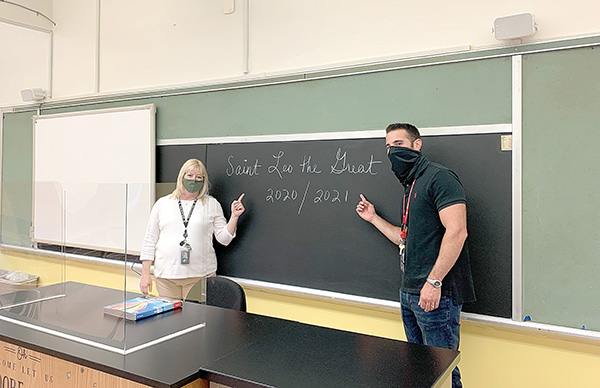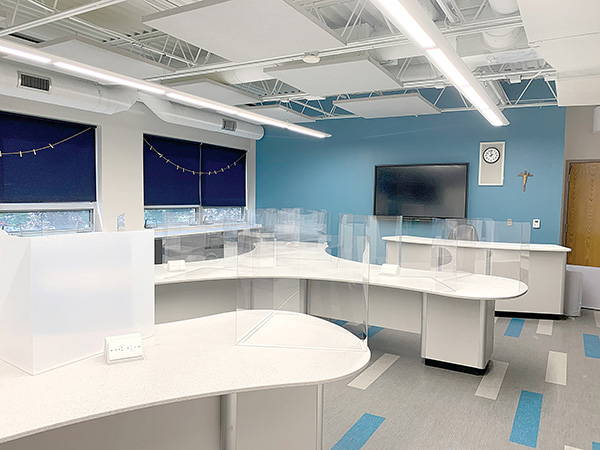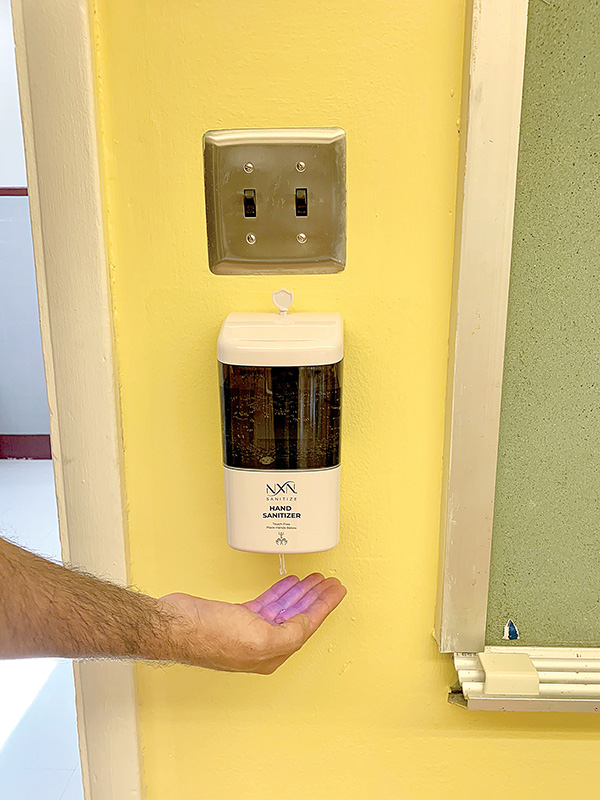By Elizabeth Wulfhorst

St. Leo the Great School vice principals Caroline Fitzgerald, left, and David Guglietti demonstrate how face coverings will be worn by all when school reopens Sept. 1, just one of many safety precautions instituted by the school.
Plexiglas shields. One-way staircases. Daily temperature checks. And of course, face masks. These are just a few of the many new procedures schools are implementing to keep students and faculty safe and healthy when they return for the 2020-21 academic year.
The New Jersey Department of Education published “The Road Back: Restart and Recovery Plan for Education” in June which provides guidance for schools in the state. It emphasized the importance of in-person instruction and required schools to prepare reopening plans for the 2020-21 school year. In July the NJDOE clarified its guidance, saying schools must allow parents to choose fully remote learning for their children if they so desire.
Many schools have been working on reopening plans since the spread of COVID-19 caused the shutdown, not knowing when that might occur.
“Once it started, we’ve been working on some plan to come back to school,” said Neil Begley, principal of St. Leo the Great School in Lincroft. “That ultimately was the goal. Truthfully, we’ve been working on it since March. As far as doing all the final pieces, really we were just waiting to see what the governing guidance would be.”
In a release Aug. 13, the New Jersey Department of Health recommended basic precautions for all schools, including cleaning and disinfecting frequently touched surfaces at least daily; providing adequate hand hygiene supplies; physical distancing measures through barriers, a reduction in class sizes or both; and having everyone wear face coverings.
St. Leo’s will be returning to full-day, five-day-a-week in-person instruction beginning Sept. 1 with these new safety precautions in place plus many more. “Obviously, your children are the most precious treasure,” Begley said, “and everyone wants to make sure everyone is safe.”
To accomplish that, the school purchased new desks for the preschool, kindergarten and first-grade classrooms; students in those classes were previously seated at communal tables. Desks throughout the school now sport Plexiglas shields. A shoe-sanitizing mat system was installed inside the entrance to the school to remove germs from the soles and treads of shoes before people walk around the building.
St. Leo’s purchased cleaning equipment to electrostatically clean the classrooms and laptops for all the faculty and staff to be able to work remotely. “One of the biggest expenditures,” noted Begley, “was a bipolar ionization system into our HVAC to make sure that the air was clean throughout the building.”
Students, faculty and staff will be screened daily for symptoms using a health screening app and random temperature checks will occur throughout the day. Stag- gered arrival and departure times will help keep families socially distant. Everyone must wear a mask while in the building unless seated behind their Plexiglas shield, and even then mask-wearing is encouraged. Accommodations have been made to safely and respectfully isolate any student or staff who falls ill during the school day.
Making all of these upgrades comes at a cost. “We spent about $425,000 that was not in the budget,” Begley said, money which will be recouped through fundraising efforts which have already begun.
Most students will be reaping the benefits of the safety improvements but, in accordance with the state directive, St. Leo’s is also offering remote learning for any student who requests it.

St. Leo the Great School vice principals Caroline Fitzgerald, left, and David Guglietti demonstrate how face coverings will be worn by all when school reopens Sept. 1, just one of many safety precautions instituted by the school.
“I think people are definitely nervous just because we haven’t been to school in five months,” Begley said, but he noted that a little less than 10 percent of the school population had opted for remote learning for the first trimester, a low number he at- tributed to the safety protocols St. Leo’s has instituted.
“Everybody’s at a different place” right now, said Begley, and the administration wanted to offer an option for parents not ready to send their children back into a school building. Those students should still have the opportunity to be part of the class, he said. Lessons will be simulcast for remote learning students who are expected to follow their class schedule each day and participate in lessons to receive credit for school attendance.
“Most people, if not all people, recognize that children have missed out on a huge component of their development” by missing months of in-person learning, Begley said. “To be able to get the kids back into a place where they can socialize and interact with each other is a big deal.”
But the expectation is that students may get sick at some point, if not with COVID-19, then with the flu or common cold, and mak- ing remote learning easy, accessible and convenient will help educational continuity.
“Kids are going to be missing school and so we wanted to create a culture where, if your kid looks sick or feels sick…keep your kid home from school,” Begley said. He feels historically, parents would err on the side of sending a child who was under the weather to school so they wouldn’t miss a test or lessons, but “we want to try to create an environment where you aren’t missing anything if you miss school,” he said.
“I think the world of education has changed now and it’s transformed. So, I think what we have to be able to do is offer education at the location of wherever the child is going to be,” Begley said.

In addition to large-scale safety measures, like a bipolar ionization system installed in the school’s HVAC unit, small steps like hand sanitizing stations and daily health screenings will greet students returning to St. Leo’s this fall.
St. Leo’s 21-page Return to School Plan is just one of many created by academic institutions in the Two River area. Here are some of the ways other districts and schools are handling students coming back to school in the next weeks.
The Middletown Township Public School District has an entire website dedicated to its reopening plans. The “information hub” includes a wealth of information about ac- ademics, athletics and health, safety and more, FAQs, links to explanations of virtual learning and state guidelines, and videos showing why mask usage is so important and the proper use of PPE.
The district developed a six-phased re- opening plan for its 16 elementary, middle and high schools for in-person learning. The administration will work with the Mid- dletown Township Department of Health, the district physician, and assess chang- ing guidelines from the state to determine when each phase is implemented. Phases 1 and 2 are for staff development; Phase 2 includes “reentry meetings” for staff and students conducted either through scheduled in-person appointments or virtually. During these meetings staff will go over the new rules and the expectations for students, including wearing face coverings and social distancing.
Classes resume Sept. 14 for all students across all grade levels. Students will be di- vided into two sections alphabetically and attend class five days a week with short- ened schedules: Those with last names A-K will be in the school building for in-person classes Mondays and Tuesdays while their peers in the latter half of alphabet receive virtual instruction. On Thursdays and Fridays the roles will be reversed. All students will participate in remote virtual learning Wednesdays. Students may also choose remote-only learning, an option mandated by the state.
Phases 4 and 5 could increase class siz- es and also the length of the school day, incrementally; Phase 6 would be a return to in-person learning for all students, something the district doesn’t anticipate happening until December at the earliest.
Holy Cross Academy in Rumson plans to open Sept. 8. After a one-week phase-in period of half days, full-day instruction will resume on week two.
“Our goal has been to return to normal operations to the fullest extent permitted by research-based health and safety guidelines,” Mark DeMareo, Holy Cross Academy principal said in a statement.
The school can accommodate 15 socially distanced students in each of its classrooms; classes will be split to keep to those guidelines, with staff using other rooms in the school, such as the library and conference rooms, if necessary. Google Classroom and Zoom will be used for any virtual online learning.
Students and staff will have their temperatures taken every day as they arrive at school. Face coverings will be required, enhanced cleaning and sanitation procedures have been implemented, and the school has restricted visitors and introduced new handwashing measures. “As the COVID-19 situation and guidance continues to change, our plans will also continue to change,” DeMareo added.
Christian Brothers Academy announced Aug. 3 that it would be bringing all students back to its campus in Lincroft for five-day-a-week learning Sept. 11. CBA surveyed the parents and faculty when planning reopening procedures.
All students will be required to wear masks when they are not able to maintain six feet of social distance. The school cited American Academy of Pediatrics recom- mendations for placing desks at least three feet apart in the classroom. Lunch periods will be spread around the campus and students will be required to remain six feet apart.
Students will not be going to homeroom before school and won’t be using lockers. Daily health screenings and Plexiglas shields are now part of the school day. A bi- polar ionization system was installed in every HVAC unit to clean the air, eliminating bacteria, mold, allergens and viruses.
Susan Chilvers, director of The New School of Monmouth County in Holmdel, said the school’s philosophy “recognizes the need to involve children in their own education with hands-on experiences and embraces their natural curiosity and desire to learn.”
The administration is still working to determine what combination of online, class- room and even outdoor learning will be appropriate this fall. As a small school, which can accommodate up to 45 or 50 students in three age groups, Chilvers feels on-site learning is a viable option for their students. “Our small numbers give us a big advantage in terms of space and social distancing. We also have a great outdoor playing area and a park and nature trails next door,” Chilvers said. She hopes a hybrid program serves the needs of all families, “including those who may be reluctant to return to the building until they feel it is safe for them personally.”
Parents have been an integral part of the decision-making process for returning stu- dents to the school.
Oak Hill Academy in Lincroft will be offering in-person classes five days a week, starting in September. Oak Hill’s online option using Swivl technology will allow students to livestream all of their regular classes to give families “more flexibility in managing their child’s education,” according to a release.
The Swivl technology allows real-time access to the teacher and the classroom for students opting for remote learning, giving them the ability to participate in group projects and presentations and to complete assignments at the same time as their in-person peers. Students in grades three through eight will also be issued their own Chromebook.
The school will continue to make adjustments to its plans and add additional safety measures as needed.
All reopening plans are fluid as the NJ- DOE releases new information and guidance. Check with your local school district for complete and updated information.
This article originally appeared in the Aug. 20 – 26, 2020 print edition of The Two River Times.














